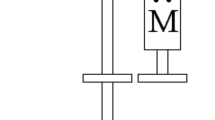Abstract
This paper describes adaptive methods for both pattern recognition and control in an experimental mobile vehicle (MV). An adaptive resonance theory (ART) neural network is used as the character recognizer. It can self-organize and self-stabilize in response to complex binary input vectors. New input patterns can be saved in such a fashion that the stored patterns are not forgotten or destroyed. By merging the advantages of the feed-forward neural network, adaptive algorithm, and fuzzy control, a neuro-fuzzy system also is proposed. This can deal with a large amount of training data in the neural network, from these data produce more reasonable fuzzy rules with the adaptive algorithm, and then control the object by fuzzy control. This is not a simple combination of the three methods, but a merger into one intelligent control system. Finally, the experimental results and some conclusions are given.
Similar content being viewed by others
References
Watanabe K, Izumi K (1998) Construction of fuzzy behavior-based control systems for a mobile robot. Proceedings of the 3rd International Symposium on Artificial Life and Robotics, Oita, Japan. vol 2, p 518–523
Wang H, Goh CT (1999) Fuzzy logic Kalman filter estimation for 2-wheel steerable vehicles. Proceedings of the 1999 IEEE/RSJ International Conference on Intelligent Robots and Systems, Kyongju, Korea, vol 1, p 88–93
Wang X (1998) Development of intelligent control strategies for a mobile vehicle. PhD Thesis, Department of Electrical and Electronic Engineering, Oita University
Heins LG, Tauritz DR (1995) Adaptive resonance theory (ART): an introduction. IR-95-35, May/June, 1995, Department of Computer Science, Leiden University, http://www.wi.leidenuniv.nl/art/#Bibliography
Hagihara M (1994) Neuron, fuzzy, GA (in Japanese). Sangyou, Tokyo
Abe S (1995) Neural network and fuzzy: theory and applications (in Japanese). Kindai Scientific, Tokyo
Bartfai G (1994) Hierarchical clustering with ART neural networks. Technical Report CS-TR-94/1, Victoria University of Wellington
Wang J-S, Lee CSG (2001) Efficient neuro-fuzzy control systems for autonomous underwater vehicle control. Proceedings of the 2001 IEEE International Conference on Robotics and Automation, Seoul, Korea, p 2986–2991
Jiao L-C (1993) Neural network application and realization (in Chinese). Xi’an Electronic Science and Technology University Press, Xi’an
Sugisaka M, Dai F (2002) Application of adaptive strategies to an intelligent mobile vehicle. Proceedings of the 12th Intelligent System Symposium (Fuzzy, Artificial Intelligence, Neural Networks and Computational Intelligence, FAN’02 in Saga), Saga, Japan, p 207–210
Author information
Authors and Affiliations
Corresponding author
About this article
Cite this article
Sugisaka, M., Dai, F. Pattern recognition and control by adaptive methods for an intelligent mobile vehicle. Artificial Life and Robotics 7, 164–169 (2004). https://doi.org/10.1007/BF02471200
Received:
Accepted:
Issue Date:
DOI: https://doi.org/10.1007/BF02471200



